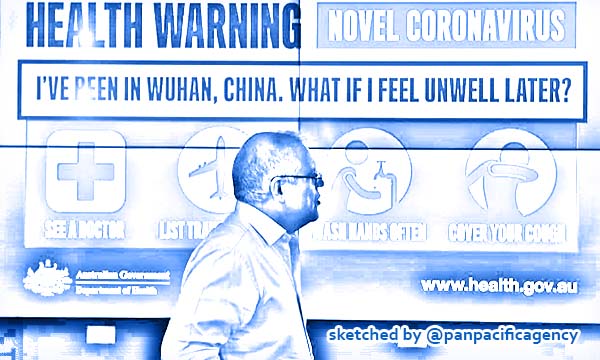Reserve Bank has released its three options for Australian unemployment – and even the best case scenario leaves a million out of work

The prime minister, Scott Morrison, at the National Incident Room of the Department of Health in Canberra. A Chinese national in Melbourne is the first confirmed case of coronavirus in Australia. Photograph: Mick Tsikas/AAP. Sketched by the Pan Pacific Agency.
CANBERRA, May 14, 2020, News.com.au. Today is a tough day for Australia – “terribly shocking” as Prime Minister Scott Morrison said in a press conference this morning, shortly after the Australian Bureau of Statistics released its latest unemployment figures, News.com.au reported.
So far, almost 600,000 Australians have lost their jobs, bumping the unemployment rate up one full percentage point, from 5.2 per cent to 6.2 per cent.
But what’s to come is far, far more bleak.
Last week the Reserve Bank mapped out three possible outcomes for the future of jobs in Australia. It modelled a baseline scenario, an upside scenario and a downside scenario.
None of the scenarios are good, as the next graph shows.
THE UPSIDE
Even the upside scenario has a million people out of work and unemployment peaking over
10 per cent. But in this upside scenario the bad times don’t last. The labour market heals quickly and is back to its current levels within about two years.
The assumption is that we beat the virus, and people get their confidence back.
“Because of the better health outcomes and policy stimulus in place, the rebound in consumer demand and reduced uncertainty about the outlook would allow businesses to rehire workers and resume investment plans quickly,” the RBA said when describing the upside scenario.
THE BASELINE
We shouldn’t expect the upside scenario.
The RBA thinks a more realistic scenario is that unemployment is still over 6 per cent in two years’ time. This is their baseline, the outcome they think is most likely.
But the baseline is still a fast recovery by historical standards. It usually takes many years for unemployment to recover from a recession, as the next graph shows.
The RBA expects this time to be different “because the downturn has been driven by health-related restrictions, not economic factors”.
That’s somewhat fair, assuming the virus doesn’t come back.
Once lockdowns are done we can return to our usual economic lives – working and spending.
There is reason to hope that some parts of the economy can “snap back”.
This is what Treasurer Josh Frydenberg was talking about on Tuesday.
“Treasury estimates that the benefits of just stage one being lifted will lead to more than 250,000 people going back to work and more than $3 billion in additional GDP,” he said.
Another little bonus for the speed of the recovery – jobs lost were mostly in businesses with high turnover of staff, like hospitality. It’s quicker to re-hire 10,000 bar staff and waiters than it is to hire 10,000 qualified tradies or nurses.
THE DOWNSIDE
The downside scenario is much gloomier than the baseline.
In this scenario, we spend a full year with unemployment over 10 per cent. That drags out the recovery.
By 2022, unemployment is still higher than it was a few months ago – well over 7 per cent.
That means looking for a job would be very hard for a very long time.
One of the problems in the downside scenario is even people who do have jobs are forced to take one that doesn’t suit their skills, such as driving for Uber. That’s an example of what the RBA calls a “poor match”.
“The longer the economy remains weak, the more employment relationships are severed and the more households and firms will suffer severe financial stress. This would slow the recovery further and increase the chance that workers need to take jobs that are poor matches for their skills,” the RBA said.
The downside scenario will come true, the RBA reckons, if travel restrictions are in place
until next year, if we need to go back to restrictions due to a second wave, or if household and business confidence remains low. Any or all of which seem quite plausible.
IS THERE ENOUGH DOWNSIDE IN THEIR SCENARIO?
The RBA’s downside scenario seems gloomy. But is their “bad” scenario bad enough?
After all, it still has unemployment falling swiftly in 2021, and it assumes international travel restrictions will be lifted in 2021. They might not be.
Australia is a medium-sized trading nation, and as such we depend a lot on the rest of the world – especially the United States.
The US is doing everything wrong in managing this virus. If there is going to be a big second wave of infections anywhere, it will be in America. That would slow down growth in the world’s biggest economy and inevitably it would have an effect on Australia.
Another big consequence of the pandemic seems to be worsening relations with China.
On Tuesday, China put a ban on imports of beef from four Australian abattoirs. That’s just a
warning shot from them about what could come next.
Without China, the chances of Australia’s economy returning to its previous highs seem remote.
There’s also the possibility of a big downturn in Australian real estate.
Residential vacancies in Sydney’s CBD have risen from 6.5 per cent a year ago to 13.8 per cent in April.
Commercial landlords are in an even worse position, with retail and office space suddenly looking very much in surplus.
The RBA likes to make its forecasts symmetrical, where the downside and the upside are
balanced. But the pandemic is like the butterfly effect – consequences will spiral out in ways that are very hard to predict.
That means that while the best case scenario is just a return to boring old normal, the worst downside scenario is not just the mirror image of that – it’s much worse.
Jason Murphy is an economist. He is the author of the new book Incentivology